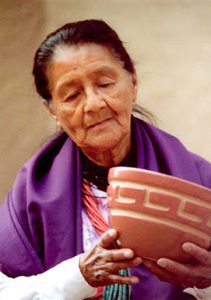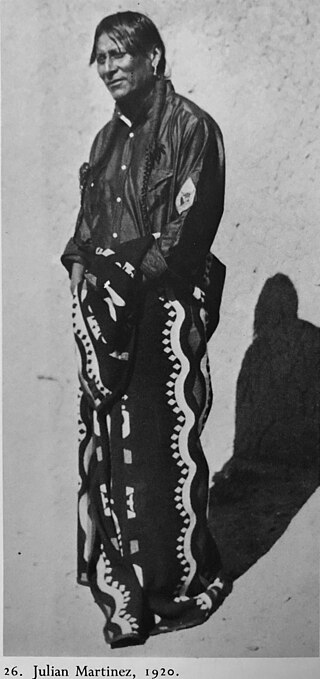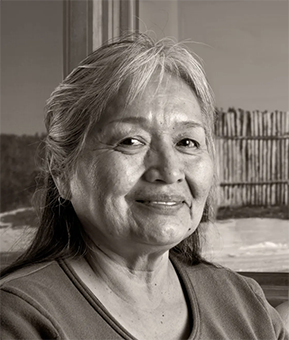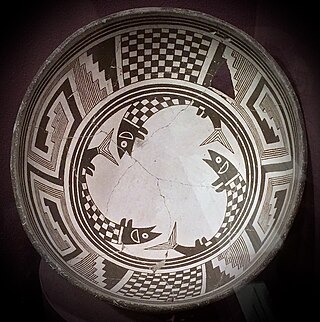
The Taos art colony was an art colony founded in Taos, New Mexico, by artists attracted by the culture of the Taos Pueblo and northern New Mexico. The history of Hispanic craftsmanship in furniture, tin work, and other mediums also played a role in creating a multicultural tradition of art in the area.

Nampeyo was a Hopi-Tewa potter who lived on the Hopi Reservation in Arizona. Her Tewa name was also spelled Num-pa-yu, meaning "snake that does not bite". Her name is also cited as "Nung-beh-yong," Tewa for Sand Snake.

Maria Poveka Montoya Martinez was a Puebloan artist who created internationally known pottery. Martinez, her husband Julian, and other family members, including her son Popovi Da, examined traditional Pueblo pottery styles and techniques to create pieces which reflect the Pueblo people's legacy of fine artwork and crafts. The works of Maria Martinez, and especially her black ware pottery, are in the collections of many museums, including the Smithsonian, the Metropolitan Museum of Art, the Denver Art Museum, and more. The Penn Museum in Philadelphia holds eight vessels – three plates and five jars – signed either "Marie" or "Marie & Julian".

Lucy Martin Lewis was a Native American potter from Acoma Pueblo, New Mexico. She is known for her black-on-white decorative ceramics made using traditional techniques.

Crucita Gonzales Calabaza, also known as Blue Corn, was a Native American artist and potter from San Ildefonso Pueblo, New Mexico, in the United States. She became famous for reviving San Ildefonso polychrome wares and had a very long and productive career.

Maria Margarita "Margaret" Tafoya was the matriarch of Santa Clara Pueblo potters. She was a recipient of a 1984 National Heritage Fellowship awarded by the National Endowment for the Arts, which is the United States government's highest honor in the folk and traditional arts.
Anita Louise Suazo is a Native American potter from Santa Clara Pueblo, New Mexico, United States.
Anthony Durand (1956–2009) was a Puebloan potter from Picuris Pueblo, New Mexico, United States. He was born in Cortez, Colorado and raised by his grandparents at Picuris Pueblo. He attended primary and secondary school in Peñasco, New Mexico and college at New Mexico Highlands University. When he returned to Picuris in 1976, he became intent on preventing the Picuris micaceous tradition of pottery from dying out. He had an excellent teacher in his grandmother Cora Durand. In 1976, Cora and Francis Martinez were the only ones making traditional Picuris-style pottery. With inspiration from his grandmother, Anthony was producing pottery on a full-time basis within a year.

Julián Martínez, also known as Pocano (1879–1943), was a San Ildefonso Pueblo potter, painter, and the patriarch of a family of Native American ceramic artists in the United States.
Tammie Allen is a contemporary Native American potter, enrolled in the Jicarilla Apache Nation.

The Millicent Rogers Museum is an art museum in Taos, New Mexico, founded in 1956 by the family of Millicent Rogers. Initially the artworks were from the multi-cultural collections of Millicent Rogers and her mother, Mary B. Rogers, who donated many of the first pieces of Taos Pueblo art. In the 1980s, the museum was the first cultural organization in New Mexico to offer a comprehensive collection of Hispanic art.

Art of the American Southwest is the visual arts of the Southwestern United States. This region encompasses Arizona, New Mexico, and parts of California, Colorado, Nevada, Texas, and Utah. These arts include architecture, ceramics, drawing, filmmaking, painting, photography, sculpture, printmaking, and other media, ranging from the ancient past to the contemporary arts of the present day.
Lisa Holt and Harlan Reano are a husband-and-wife team of Pueblo potters and artists from northern New Mexico. They have been making pottery together in 1999, they use traditional Cochiti pottery techniques and create modern work.

Christine McHorse, also known as Christine Nofchissey McHorse, was a Navajo ceramic artist from Santa Fe, New Mexico.
Cora L. Durand was a Picuris Pueblo potter. Durand started working as a potter later in life, beginning in the 1950s. She helped maintain the traditional hand-built method for creating micaceous pottery. Her work is utilitarian and was meant to be used.
Maria Ramita Simbolo Martinez"Summer Harvest" was a Picuris Pueblo potter. Martinez learned traditional methods of creating pottery and has been recognized for preserving a cultural tradition of the Picuris Pueblo. Martinez collaborated with her husband, Juan José Martinez, who decorated her finished pots.
Juanita Inez Ortiz, also known as Inez Ortiz was a Native American Cochiti Pueblo artist, specializing in pottery. She is of the Herrera family of Pueblo potters in New Mexico, whose work is often found in art collections and in art museums. She was from the Cochiti Pueblo in Cochiti, New Mexico.
Susan Folwell is a Native American artist from Santa Clara Pueblo, New Mexico, known for her work in the ceramic industry. Her work ties in Native designs and history and has been used by Folwell to demonstrate her viewpoints on society and politics. Folwell has been described by the Heard Museum as an "innovator in Pueblo pottery".

Black-on-black ware is a 20th- and 21st-century pottery tradition developed by Puebloan Native American ceramic artists in Northern New Mexico. Traditional reduction-fired blackware has been made for centuries by Pueblo artists and other artists around the world. Pueblo black-on-black ware of the past century is produced with a smooth surface, with the designs applied through selective burnishing or the application of refractory slip. Another style involves carving or incising designs and selectively polishing the raised areas. For generations several families from Kha'po Owingeh and P'ohwhóge Owingeh pueblos have been making black-on-black ware with the techniques passed down from matriarch potters. Artists from other pueblos have also produced black-on-black ware. Several contemporary artists have created works honoring the pottery of their ancestors.

Pueblo pottery are ceramic objects made by the indigenous Pueblo people and their antecedents, the Ancestral Puebloans and Mogollon cultures in the Southwestern United States and Northern Mexico. For centuries, pottery has been central to pueblo life as a feature of ceremonial and utilitarian usage. The clay is locally sourced, most frequently handmade, and fired traditionally in an earthen pit. These items take the form of storage jars, canteens, serving bowls, seed jars, and ladles. Some utility wares were undecorated except from simple corrugations or marks made with a stick or fingernail, however many examples for centuries were painted with abstract or representational motifs. Some pueblos made effigy vessels, fetishes or figurines. During modern times, pueblo pottery was produced specifically as an art form to serve an economic function. This role is not dissimilar to prehistoric times when pottery was traded throughout the Southwest, and in historic times after contact with the Spanish colonialists.











